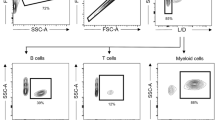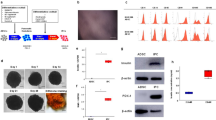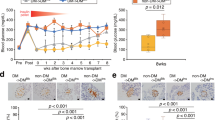Abstract
Type I diabetes mellitus is a metabolic disease caused by chronic immune attack against the insulin-producing cells of the pancreas. It has recently been shown that the clinical course of this disease can be interrupted by immune ablation and PBSCT. In this report, we describe our experience with this treatment modality in a series of eight cases. Patients with newly diagnosed type I diabetes were received treatment consisting of two to three plasmaphereses, hematopoietic stem cell mobilization with CY and G-CSF, collection of at least 3 × 106 per kg of CD34+ cells, and conditioning with CY and anti-thymocyte globulin followed by stem cell infusion. All patients became independent of exogenous insulin after the transplantation. One patient resumed low-dose insulin 7 months after transplantation. Six out of eight patients were given acarbose for better glycemic control after transplantation. All patients exhibited good glycemic control: the average HbA1c concentrations were 12.3% at diagnosis, and 5.6 and 6.2% at 3 and 6 months after transplantation, respectively. We conclude that at least temporary independence of exogenous insulin can be achieved in type I diabetes patients following immunoablation and reconstitution of the immune system with autologous PBSCs.
This is a preview of subscription content, access via your institution
Access options
Subscribe to this journal
Receive 12 print issues and online access
$259.00 per year
only $21.58 per issue
Buy this article
- Purchase on Springer Link
- Instant access to full article PDF
Prices may be subject to local taxes which are calculated during checkout

Similar content being viewed by others
References
Voltarelli JC, Couri CE, Stracieri AB, Oliveira MC, Moraes DA, Pieroni F et al. Autologous non-myeloablative hematopoietic stem cell transplantation in newly diagnosed type 1 diabetes mellitus. JAMA 2007; 297: 1568–1576.
Couri CE, Oliveira MC, Stracieri AB, Moraes DA, Pieroni F, Barros GM et al. C-peptide levels and insulin independence following autologous non-myeloablative hematopoietic stem cell transplantation in newly diagnosed type 1 diabetes mellitus. JAMA 2009; 301: 1573–1579.
Noble JA, Valdes AM, Cook M, Klitz W, Thomson G, Erlich HA . The role of HLA class II genes in insulin-dependent diabetes mellitus: molecular analysis of 180 Caucasian, multiplex families. Am J Hum Genet 1996; 59: 1134–1148.
Shtauvere A, Rumba I, Dzivite I, Sanjeevi CB . HLA-DR and -DQ gene polymorphism in Latvian patients with insulin-dependent diabetes mellitus. Tissue Antigens 1998; 52: 385–388.
Thomson G, Valdes AM, Noble JA, Kockum I, Grote MN, Najman J et al. Relative predispositional effects of HLA class II DRB1-DQB1 haplotypes and genotypes on type 1 diabetes: a meta-analysis. Tissue Antigens 2007; 70: 110–127.
Erlich H, Valdes AM, Noble J, Carlson JA, Varney M, Concannon P et al. HLA DR-DQ haplotypes and genotypes and type 1 diabetes risk: analysis of the type 1 diabetes genetics consortium families. Diabetes 2008; 57: 1084–1092.
Brodsky RA, Jones RJ . Intensive immunosuppression with high dose cyclophosphamide but without stem cell rescue for severe autoimmunity: advantages and disadvantages. Autoimmunity 2008; 41: 596–600.
Burt RK, Loh Y, Pearce W, Beohar N, Barr WG, Craig R et al. Clinical applications of blood-derived and marrow-derived stem cells for non-malignant diseases. JAMA 2008; 299: 925–936.
Ludvigsson J, Heding L, Liedén G, Marner B, Lernmark A . Plasmapheresis in the initial treatment of insulin-dependent diabetes mellitus in children. Br Med J (Clin Res Ed) 1983; 286: 176–178.
Bonora E . Protection of pancreatic beta-cells: is it feasible? Nutr Metab Cardiovasc Dis 2008; 18: 74–83.
Couri CE, Oliveira MC, Stracieri AB, Moraes DA, Pieroni F, Barros GM et al. C-peptide levels and insulin independence following autologous non-myeloablative hematopoietic stem cell transplantation in newly diagnosed type 1 diabetes mellitus. JAMA 2009; 301: 1573–1579.
Author information
Authors and Affiliations
Corresponding author
Ethics declarations
Competing interests
The authors declare no conflict of interest.
Rights and permissions
About this article
Cite this article
Snarski, E., Milczarczyk, A., Torosian, T. et al. Independence of exogenous insulin following immunoablation and stem cell reconstitution in newly diagnosed diabetes type I. Bone Marrow Transplant 46, 562–566 (2011). https://doi.org/10.1038/bmt.2010.147
Received:
Revised:
Accepted:
Published:
Issue Date:
DOI: https://doi.org/10.1038/bmt.2010.147
Keywords
This article is cited by
-
Investigating the safety and efficacy of hematopoietic and mesenchymal stem cell transplantation for treatment of T1DM: a systematic review and meta-analysis
Systematic Reviews (2022)
-
Safety and efficacy of hematopoietic and mesanchymal stem cell therapy for treatment of T1DM: a systematic review and meta-analysis protocol
Systematic Reviews (2018)
-
Immune Mechanisms and Pathways Targeted in Type 1 Diabetes
Current Diabetes Reports (2018)
-
Immunoablation and autologous hematopoietic stem cell transplantation in the treatment of new-onset type 1 diabetes mellitus: long-term observations
Bone Marrow Transplantation (2016)
-
Immune Intervention and Preservation of Pancreatic Beta Cell Function in Type 1 Diabetes
Current Diabetes Reports (2016)



